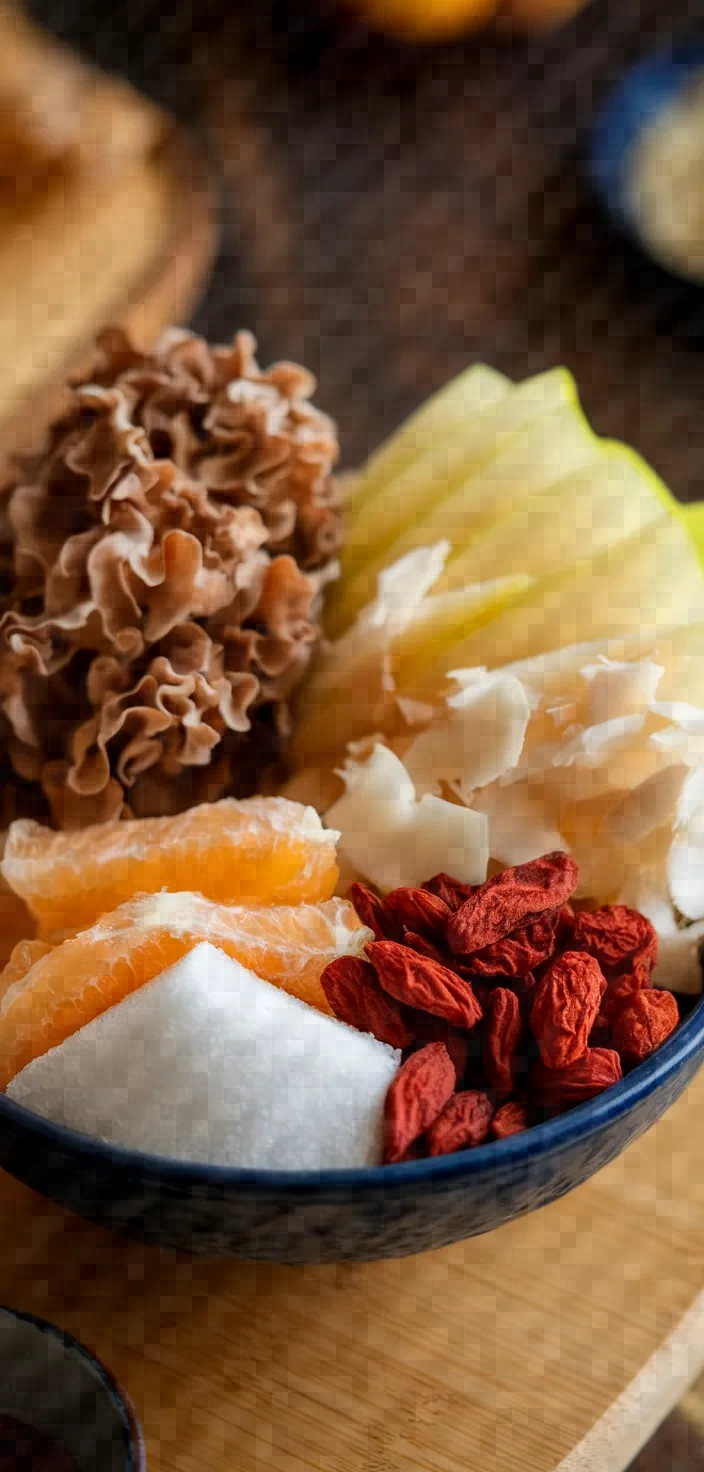Dive into a bowl of this delightfully soothing treat, where each spoonful feels like a comforting hug with a blend of snow fungus, Asian pears, and sea coconut—it’s like I discovered a secret wellness potion handed down through the generations.

Autumn Tong Sui is a delightful sweet soup from Cantonese cuisine that I love to prepare as the weather cools. There are nourishing qualities in the snow fungus, which is reputed to be very rich in collagen and good for the complexion.
Plus, it is gelatinous and gives the kind of mouthfeel that makes the tongue tingle and the brain think of dessert. Asian pears are in season and at the top of my list of delicious fruits.
We also love the goji berries, which we now know are superfoods with many benefits. Finally, there is the sea coconut, which contains a lot of water and gives the dish the kind of mouthfeel that makes the tongue tingle and the brain think of dessert.
Autumn Tong Sui Snow Fungus Pear And Sea Coconut Cantonese Sweet Soup Recipe Ingredients

- Snow Fungus: Rich in fiber and collagen; known for boosting skin health.
- Asian Pears: Juicy and crisp; provide natural sweetness and fiber.
- Sea Coconut: Hydrating slices; traditionally used to nourish lungs.
- Goji Berries: Tiny red superfoods; packed with antioxidants and vitamin C.
- Rock Sugar: Mildly sweetens; often used to enhance dessert flavors.
- Dried Tangerine Peel: Aromatic and slightly tangy; aids digestion.
Autumn Tong Sui Snow Fungus Pear And Sea Coconut Cantonese Sweet Soup Recipe Ingredient Quantities
- 30g dried snow fungus (white fungus)
- 2 large Asian pears (peeled, cored, and cut into chunks)
- 50g dried sea coconut slices
- 20g goji berries
- 75g rock sugar (adjust to taste)
- 1 piece of dried tangerine peel (optional)
- 10 cups water
How to Make this Autumn Tong Sui Snow Fungus Pear And Sea Coconut Cantonese Sweet Soup Recipe
1. Wash the dried snow fungus under running water to remove any dirt. Soak in warm water for about 20-30 minutes until it has reconstituted and is soft and plump. Remove any hard cores and cut the fungus into smaller, bite-sized pieces.
2. Briefly rinse the dried sea coconut slices and set them aside. Soak the goji berries in a small bowl of water for a few minutes; then drain.
3. To prepare dried tangerine peel for use, rinse it under water to eliminate any surface dust. Next, soak it in warm water until it is soft. This will probably take about 20 minutes. Remove the peel from the water and scrape off any excess pith that you can reach. The scraping is more for texture than anything else; we are not trying to eliminate the bitterness of the pith. The less pith, the better. Thin, even strips are better than thick pieces, but if you have thick pieces, don’t worry. Just use them.
4. In a large saucepan, bring 10 cups of water to a boil. Add in the snow fungus that has been soaked and prepped, slices of sea coconut, and tangerine peel, if using.
5. Allow the snow fungus to begin softening and releasing its gelatinous texture by mixing it in low heat for about 20 minutes.
6. Place the chunks of Asian pear into the pot and keep simmering for 30 minutes, but now at low heat. You should allow the lid to be partially on so that moisture can be retained.
7. Incorporate the rock sugar, adjusting the quantity to yield your desired level of sweetness. Allow it to dissolve completely, gently continuing to simmer the clear soup.
8. Place the soaked goji berries in the mixture and let it cook for another 10 minutes. This ensures that every part of the medicinal soup is as nutritious as possible. Goji berries, in particular, are beneficial for your eyesight. They are also a great blemish-remover when applied topically.
9. Sample the soup and modify the sweetness if necessary. If you want, add more rock sugar little by little until the sweetness is just right.
10. Switch off the heat, and stir it gently. Serve the soup in a warm state; or, let it cool before refrigerating if you prefer a cold version. Relish your Autumn Tong Sui with Snow Fungus, Pear, and Sea Coconut.
Autumn Tong Sui Snow Fungus Pear And Sea Coconut Cantonese Sweet Soup Recipe Equipment Needed
1. Large bowl
2. Small bowl
3. Large saucepan with lid
4. Knife
5. Cutting board
6. Measuring cup
7. Spoon or spatula for stirring
FAQ
- Q: Can I use fresh snow fungus instead of dried?Q: Can I use fresh snow fungus in a recipe?
A: Yes, you can use fresh snow fungus, but reduce the soaking time since it rehydrates more quickly. - Q: What can I substitute for rock sugar?A: White sugar or honey can be used in place of this, with the amount adjusted to meet your preference for sweetness.
- Q: Is the dried tangerine peel necessary?A: No, it’s optional—but it adds such a lovely hint of citrus that really makes the flavor pop in the soup.
- Q: Can this dessert be served cold?A: Yes, it is tasty, irrespective of whether it is served warm or cold. It is one of those rare dishes that is just as good at room temperature as it is straight from the oven.
- Q: How do I prepare the dried snow fungus?A: Wash and soak in cold water for approximately 30 minutes until it has softened and enlarged, then cut away the tough portions.
- Q: Can I add other ingredients to the soup?A: Yes, you can add more ingredients, like lotus seeds or longan, if you want to change it up.
Autumn Tong Sui Snow Fungus Pear And Sea Coconut Cantonese Sweet Soup Recipe Substitutions and Variations
30g dried snow fungus can be substituted with either 30g white wood ear mushrooms or 30g silver ear fungus for a similar texture.
Two big Asian pears can be swapped out for two big Bosc pears or two big Bartlett pears, which will also work since they too have sweet and juicy profiles.
Dried sea coconut slices 50g. Safe substitutions: Dried jujube slices 50g; dried longan 50g.
You can swap out 20g of goji berries for 20g of raisins or 20g of cranberries, which provide comparable nutrition and sweetness.
75 g rock sugar can be replaced with 75 g brown sugar or 75 g regular, granulated sugar, though brown sugar will add a slightly deeper flavor.
Pro Tips
1. Snow Fungus Prep Ensure the snow fungus is thoroughly soaked and trimmed of any tough parts before adding it to the soup. This will help it attain the right soft and gelatinous texture, enhancing the soup’s mouthfeel.
2. Tangerine Peel Flavor If using dried tangerine peel, make sure to scrape off as much pith as possible. Excessive pith can impart an overly bitter taste, which might overshadow the delicate flavors of the soup.
3. Temperature Control Maintain a gentle simmer throughout the cooking process rather than a boil. This ensures that the ingredients slowly release their flavors and maintain their texture without becoming mushy.
4. Tasting for Sweetness When adding rock sugar, start with less than the recommended amount and gradually add more to suit your taste. This prevents the soup from becoming overly sweet, allowing the natural sweetness of the pears to shine through.
5. Garnish with Freshness Consider adding a sprinkle of freshly sliced mint or a few extra goji berries on top just before serving. This will add a pop of color and a hint of freshness to each bowl.

Autumn Tong Sui Snow Fungus Pear And Sea Coconut Cantonese Sweet Soup Recipe
My favorite Autumn Tong Sui Snow Fungus Pear And Sea Coconut Cantonese Sweet Soup Recipe
Equipment Needed:
1. Large bowl
2. Small bowl
3. Large saucepan with lid
4. Knife
5. Cutting board
6. Measuring cup
7. Spoon or spatula for stirring
Ingredients:
- 30g dried snow fungus (white fungus)
- 2 large Asian pears (peeled, cored, and cut into chunks)
- 50g dried sea coconut slices
- 20g goji berries
- 75g rock sugar (adjust to taste)
- 1 piece of dried tangerine peel (optional)
- 10 cups water
Instructions:
1. Wash the dried snow fungus under running water to remove any dirt. Soak in warm water for about 20-30 minutes until it has reconstituted and is soft and plump. Remove any hard cores and cut the fungus into smaller, bite-sized pieces.
2. Briefly rinse the dried sea coconut slices and set them aside. Soak the goji berries in a small bowl of water for a few minutes; then drain.
3. To prepare dried tangerine peel for use, rinse it under water to eliminate any surface dust. Next, soak it in warm water until it is soft. This will probably take about 20 minutes. Remove the peel from the water and scrape off any excess pith that you can reach. The scraping is more for texture than anything else; we are not trying to eliminate the bitterness of the pith. The less pith, the better. Thin, even strips are better than thick pieces, but if you have thick pieces, don’t worry. Just use them.
4. In a large saucepan, bring 10 cups of water to a boil. Add in the snow fungus that has been soaked and prepped, slices of sea coconut, and tangerine peel, if using.
5. Allow the snow fungus to begin softening and releasing its gelatinous texture by mixing it in low heat for about 20 minutes.
6. Place the chunks of Asian pear into the pot and keep simmering for 30 minutes, but now at low heat. You should allow the lid to be partially on so that moisture can be retained.
7. Incorporate the rock sugar, adjusting the quantity to yield your desired level of sweetness. Allow it to dissolve completely, gently continuing to simmer the clear soup.
8. Place the soaked goji berries in the mixture and let it cook for another 10 minutes. This ensures that every part of the medicinal soup is as nutritious as possible. Goji berries, in particular, are beneficial for your eyesight. They are also a great blemish-remover when applied topically.
9. Sample the soup and modify the sweetness if necessary. If you want, add more rock sugar little by little until the sweetness is just right.
10. Switch off the heat, and stir it gently. Serve the soup in a warm state; or, let it cool before refrigerating if you prefer a cold version. Relish your Autumn Tong Sui with Snow Fungus, Pear, and Sea Coconut.
